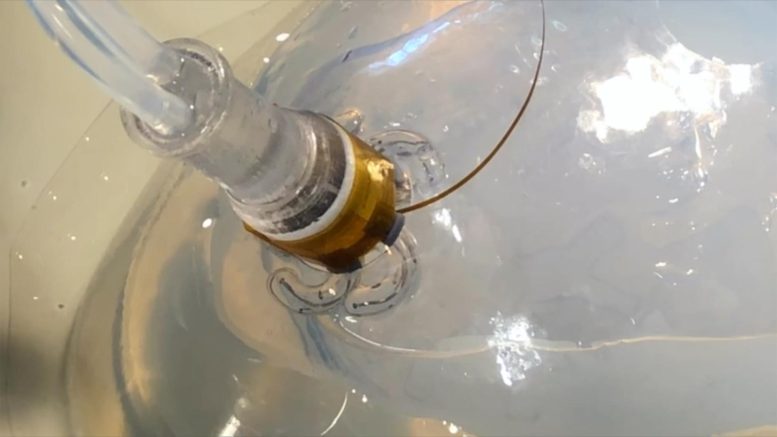
Researchers have developed an innovative, minimally invasive cortical electrode array inspired by soft robotics actuation. The array, which measures 4 cm in diameter when deployed, can be inserted through a 2 cm hole in the skull and placed between the skull and the brain without causing damage. The array features six spiraled arms that maximize surface area and electrode contact with the cortex. It is folded inside a cylindrical loader and deployed using an eversion mechanism that gently unfolds each spiraled arm over the brain tissue. The electrode array has been successfully tested in a mini-pig, and the soft neurotechnology will be scaled up by EPFL spin-off Neurosoft Bioelectronics. Credit: EPFL
Researchers at the EPFL Neuro X Institute have developed a minimally invasive, soft robotic-inspired cortical electrode array that can be inserted through a small hole in the skull. The array features six spiraled arms to maximize surface area and has been successfully tested in a mini-pig. The technology will be scaled up by EPFL spin-off Neurosoft Bioelectronics.
Stephanie Lacour’s specialty is the development of flexible electrodes that adapt to a moving body, providing more reliable connections with the nervous system. Her work is inherently interdisciplinary.
So when a neurosurgeon asked Lacour and her team to come up with minimally invasive electrodes for inserting through a human skull, they came up with an elegant solution that takes full advantage of their expertise in compliant electrodes, and inspired by soft robotics actuation. The results are published in Science Robotics.
The challenge? To insert a large cortical electrode array through a small hole in the skull, deploying the device in a space that measures about 1 mm between the skull and the surface of the brain – without damaging the brain.
“Minimally invasive neurotechnologies are essential approaches to offer efficient, patient-tailored therapies,” says Stéphanie Lacour, professor at EPFL Neuro X Institute. “We needed to design a miniaturized electrode array capable of folding, passing through a small hole in the skull and then deploying in a flat surface resting over the cortex. We then combined concepts from soft bioelectronics and soft robotics.”
EPFL scientists have developed electrode arrays that can be funneled through a small hole in the skull and deployed over a relatively large surface over the brain’s cortex. The technology may be particularly useful for providing minimally invasive solutions for epileptic patients. Interview with Stéphanie Lacour and Sukho Song. Credit: EPFL / Hillary Sanctuary, Alain Herzog
From the shape of its spiraled arms, to the deployment of each arm on top of highly sensitive brain tissue, each aspect of this novel, deployable electrode is ingenious engineering.
The first prototype consists of an electrode array that fits through a hole 2 cm in diameter, but when deployed, extends across a surface that’s 4 cm in diameter. It has 6 spiraled-shaped arms, to maximize the surface area of the electrode array, and thus the number of electrodes in contact with the cortex. Straight arms result in uneven electrode distribution and less surface area in contact with the brain.
Somewhat like a spiraled butterfly intricately squeezed inside its cocoon before metamorphosis, the electrode array, complete with its spiraled-arms, is neatly folded up inside a cylindrical tube, i.e. the loader, ready for deployment through the small hole in the skull.
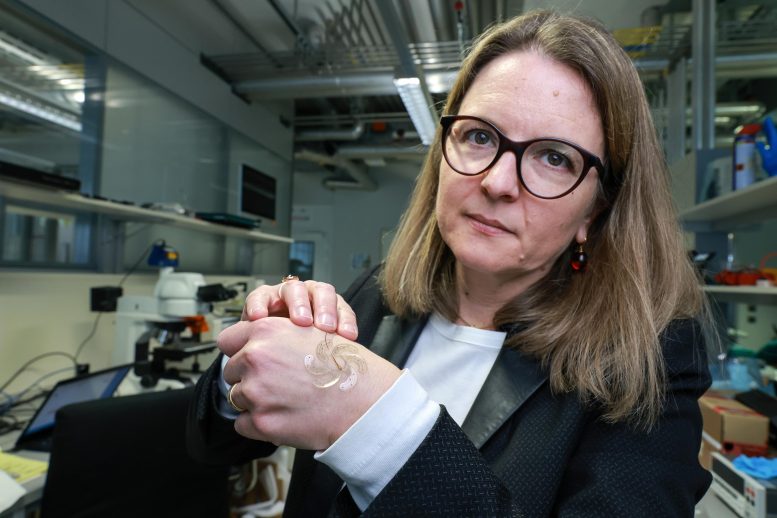
Stéphanie Lacour holds the deployable electrode, developed at EPFL. Credit: EPFL / Alain Herzog
Thanks to an everting actuation mechanism inspired from soft robotics, each spiraled arm is gently deployed one at a time over sensitive brain tissue. “The beauty of the eversion mechanism is that we can deploy an arbitrary size of electrode with a constant and minimal compression on the brain,” says Suhko Song, lead author of the study. “The soft robotics community has been very much interested in this eversion mechanism because it has been bio-inspired. This eversion mechanism can emulate the growth of tree roots, and there are no limitations in terms of how much tree roots can grow.”
The electrode array actually looks like a kind of rubber glove, with flexible electrodes patterned on one side of each spiral-shaped finger. The glove is inverted, or turned inside-out, and folded inside of the cylindrical loader. For deployment, liquid is inserted into each inverted finger, one at a time, turning the inverted finger right side out as it unfolds over the brain.
Song also explored the idea of rolling up the arm of the electrode as a strategy for deployment. But the longer the arm, the thicker it becomes when rolled up. If the rolled-up electrode becomes too thick, then it would inevitably take up too much room between the skull and the brain, placing dangerous amounts of pressure on the brain tissue.
The electrode pattern is produced by evaporation of flexible gold onto very compliant elastomer materials.
So far, the deployable electrode array has been successfully tested in a mini-pig. The soft neurotechnology will now be scaled by Neurosoft Bioelectronics, an EPFL spin-off from the Laboratory for Soft Bioelectronic Interfaces, that will lead its clinical translation. The spin-off was recently granted 2.5 million CHF Swiss Accelerator by Innosuisse.
References:
“Deployment of an electrocorticography system with a soft robotic actuator” by Sukho Song, Florian Fallegger, Alix Trouillet, Kyungjin Kim and Stéphanie P. Lacour10 May 2023, Science Robotics.
DOI: 10.1126/scirobotics.add1002
“MRI-Compatible and Conformal Electrocorticography Grids for Translational Research” by Florian Fallegger, Giuseppe Schiavone, Elvira Pirondini, Fabien B. Wagner, Nicolas Vachicouras, Ludovic Serex, Gregory Zegarek, Adrien May, Paul Constanthin, Marie Palma, Mehrdad Khoshnevis, Dirk Van Roost, Blaise Yvert, Grégoire Courtine, Karl Schaller, Jocelyne Bloch and Stéphanie P. Lacour, 8 March 2021, Advanced Science.
DOI: 10.1002/advs.202003761
“Guidelines to Study and Develop Soft Electrode Systems for Neural Stimulation” by Giuseppe Schiavone, Xiaoyang Kang, Florian Fallegger, Jérôme Gandar, Grégoire Courtine and Stéphanie P. Lacour, 28 October 2020, Neuron.
DOI: 10.1016/j.neuron.2020.10.010
“Neuroprosthetic baroreflex controls haemodynamics after spinal cord injury” by Jordan W. Squair, Matthieu Gautier, Lois Mahe, Jan Elaine Soriano, Andreas Rowald, Arnaud Bichat, Newton Cho, Mark A. Anderson, Nicholas D. James, Jerome Gandar, Anthony V. Incognito, Giuseppe Schiavone, Zoe K. Sarafis, Achilleas Laskaratos, Kay Bartholdi, Robin Demesmaeker, Salif Komi, Charlotte Moerman, Bita Vaseghi, Berkeley Scott, Ryan Rosentreter, Claudia Kathe, Jimmy Ravier, Laura McCracken, Xiaoyang Kang, Nicolas Vachicouras, Florian Fallegger, Ileana Jelescu, YunLong Cheng, Qin Li, Rik Buschman, Nicolas Buse, Tim Denison, Sean Dukelow, Rebecca Charbonneau, Ian Rigby, Steven K. Boyd, Philip J. Millar, Eduardo Martin Moraud, Marco Capogrosso, Fabien B. Wagner, Quentin Barraud, Erwan Bezard, Stéphanie P. Lacour, Jocelyne Bloch, Grégoire Courtine and Aaron A. Phillips, 27 January 2021, Nature.
DOI: 10.1038/s41586-020-03180-w

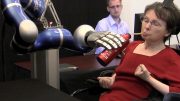

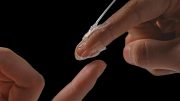
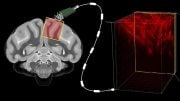



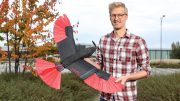
Be the first to comment on "Brain Meets Origami: Ingenious Deployable Electrodes Transform Craniosurgery"